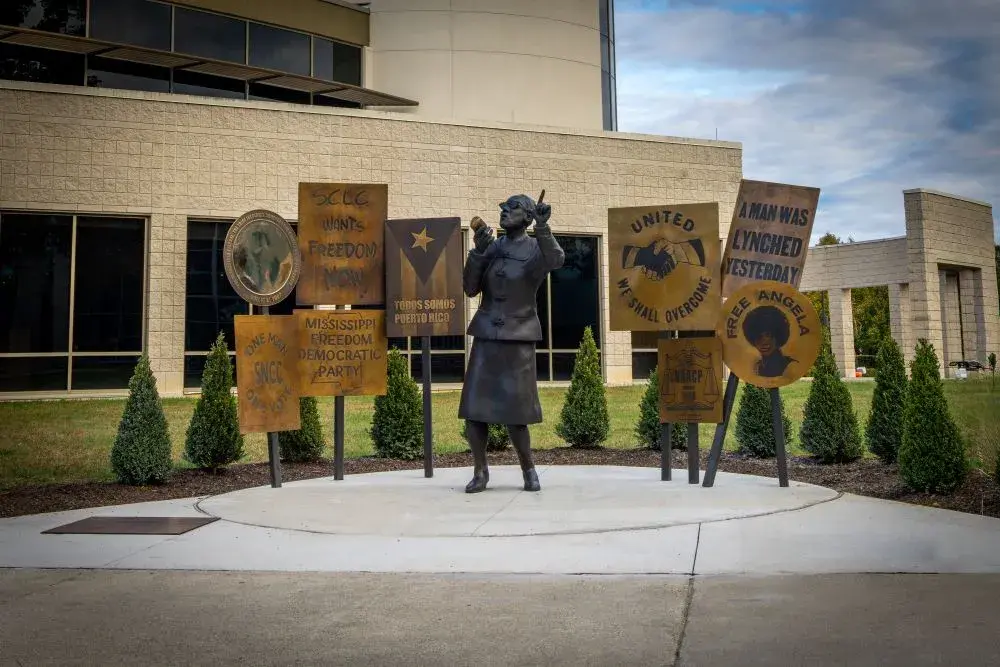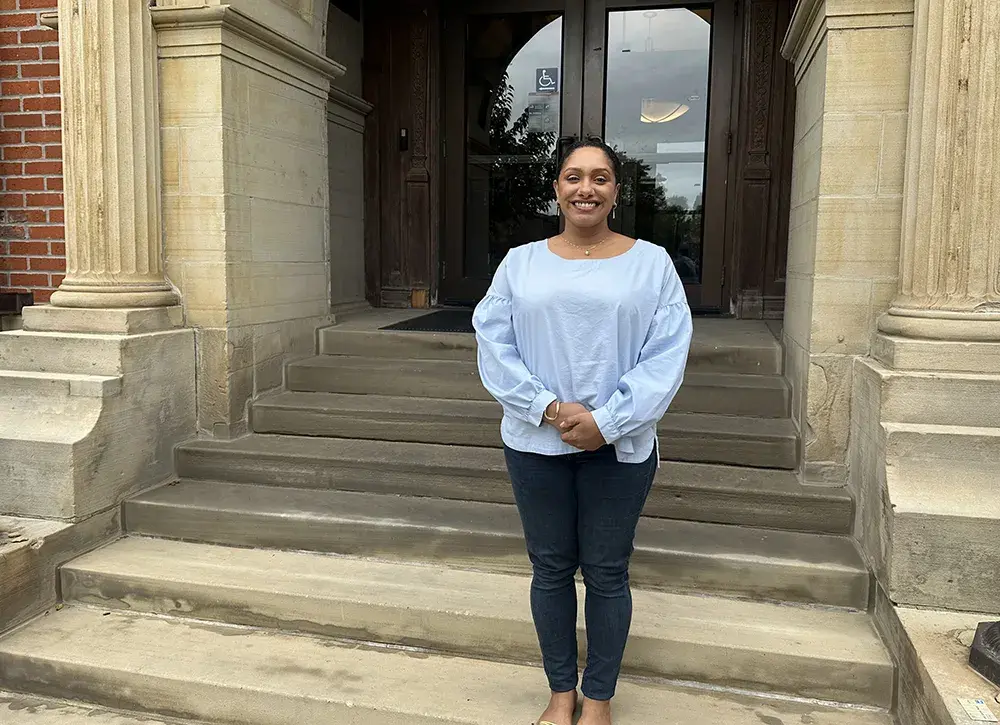Reimagining Arts Internships as Community Learning
InternshipsWhat does a “successful” internship in the arts look like?

This question has been foundational to the development of a community-centered internship/externship program at Ohio State’s Urban Arts Space (UAS), an experimental gallery located in downtown Columbus whose staff also manages Hopkins Hall Gallery on campus.
While UAS has long had a robust paid internship program, supporting 15–20 interns per semester, funding from the Mellon Foundation will allow further expansion as part of a two-semester program. The Mellon Foundation grant is part of a larger, university-wide initiative to support community engagement through the arts.
Students will spend the first semester gaining hands-on experience with tasks related to gallery operations, from exhibitions and installation to marketing and community engagement. During the second semester, interns will be placed at a community site, applying their skills and knowledge from UAS as part of a mutually beneficial relationship.
The Mellon funding also enabled UAS to hire a new Internship Program Coordinator—Ashley Martin, an educator, artist, and community advocate who previously worked with the Columbus Urban League and All People Arts, in addition to being the Director of Operations for J.U.S.T. (Justice, Unity, & Social Transformation).
Current Urban Arts Space intern Ky Smiley sat down with Ashley to discuss the new program.

New Internship Program Coordinator Ashley Martin in the Urban Arts Space offices

Ashley Martin (left) with the Urban Arts Space interns, including, to her left, Ky Smiley
What preparations are being undertaken at the gallery to expand the existing internship program?
There are a lot of moving pieces. I would say first and foremost, my job is to represent the interns and be accessible to their needs. From there, we’re building a curriculum that best presents the points of the internship, like community engagement, understanding what arts equity looks, and teaching interns to advocate for themselves. I’m also doing things you would expect a manager to do—approving time, managing schedules, having weekly meetings, and trying to be as supportive as possible for the rest of the senior staff and the interns.
How is UAS, with your efforts, reimagining arts internships as a form of community learning and engagement?
We’re trying to be as intentional as possible in our planning. For me, the internship is separated into the academic component and the real-world work experience. Trying to bridge the gap between the two has been important to me. If you imagine the curriculum as a tree, all the content connects through those six key branches: practical experience; mentorship and guidance; knowledge and skill development; networking and professional exposure; community engagement; and reflection and personal growth.
I want to ensure interns know how to advocate for themselves and make informed decisions when it comes to their careers, and that they have resources to move forward. The curriculum exists alongside different case studies within the gallery, like community events and exhibitions, where we’re working in tandem with these six pillars. Our interns will become a big part—even more so than now—of our thinking process in how we operate.
This seems like an innovative approach to arts administration, and I like your point about case studies. Could you elaborate on that? What aspects of UAS do you find most relevant or effective as a case study for future programs?
At UAS, I want students to understand how all the pieces work together to run a show. Ideally, every intern would come away with experiences directly related to their skillsets, whether with installation or community engagement, marketing or arts administration. They would understand how all those factors play a key role in making exhibitions happen.
I think the best and most innovative ideas come from students, and part of my role is to help them understand how much their thoughts and ideas contribute to our work here. I want them to realize their power not just in terms of doing tangible tasks but also in contributing ideas and testing them out. We wait too long to give young adults opportunities to realize their worth; your ideas and the way you think, especially as artists, are one of the most valuable tools you have.
For you, what’s the value of working with community organizations? How does that relate to the interns’ growth as students?
It’s very possible to go to Ohio State and to stay in the bubble that is Ohio State. I learned that even from just living close to campus, where spaces are curated for students. Sometimes they’re not able to see what happens outside of that bubble.
I think it’s extremely important to understand the role that academia plays in the layout of the city—and what you’re not seeing, who you’re not exposed to. Columbus’s history is so rich that it would be a disservice for students not to be exposed to everything Columbus has to offer, whether that’s community programming or meeting certain elders or established community members. It’s important to learn from those people and ideally make a positive impact on those communities.
For the externship, being placed at outside organizations provides perspective. It gives you more room to think about the ways that things could be done differently. Plus, if we’re all trying to meet the same goal, we can look at another organization and see how they’re doing it better. Community collaborations give you more data so you can come up with better solutions.
Also, when you graduate, there’s room for a lot of loneliness, especially if you’re switching communities. It’s important to think about the next steps, and if students want to work in those organizations, we want to help them start building relationships now. We’re giving interns a contact and making authentic connections for the future.
As someone who is involved in community advocacy and who is also an artist, how do those positions impact your approach to the internship?
It has deepened my insight on what it looks like for people to advocate for themselves and others. Advocating for yourself is really important because it’s easy to forget yourself when you’re involved in community-engaged work. In order to continue to be of service, you have to make sure you’re okay first and understand what it means to speak about what you need. Then, you’re able to teach other people how to do that.
It’s also important that people in our community understand that what they need matters. The same goes for our interns: what you need matters. Until I started volunteering with J.U.S.T., I wasn’t aware of certain issues and dynamics in the community. Being able to understand the power of a strong community has been transformative in my life. I’ve only been in Columbus for two years, but there is a difference between the person I was when I first arrived and the person I am now—and it is the people around me who shaped who I am.
What are the key steps in implementing this new internship/externship program with community partners and in-house? How do you measure success?
Getting to know you all and your individual goals as interns has been so wonderful. The first part involves centering your experience here and making sure you feel you have what you need. That, to me, is success. After that, I’m figuring out what day-to-day gallery operations and community programming look like, and how the interns play a role in those. I also completed trainings with the Course Design Institute and the Leadership Institute within the university, which was incredibly helpful to me as a manager.
Beyond that, I’ve been building a curriculum with our director, Merijn van der Heijden, and Dr. Terron Banner, our Manager of Community Learning and Experience. The curriculum reflects the learning outcomes I spoke about earlier, and we’re working on the logistics for fall semester as we pilot the externship portion. We’re ensuring that everyone is in the loop about the learning outcomes and the curriculum we’ve built, no matter where interns are placed.
There will be a smaller group of students for the first go-round, and about midway through the semester, we will have a mixer with different community partners for the spring externship. Having them come in and meet interns in an informal way allows everyone to see what their needs are and how we can collaborate.
After that, it’s about maintaining those relationships and ensuring that everyone is on the same page for the externship. We want to make sure no one is overwhelmed, especially as interns are full-time students. We’ll be continually recruiting for the next cohort, and then we’ll do the cycle all over again, taking in feedback and data to propel us forward into the next semester. From there, we can shift and adjust the syllabus across the next three years.
I admire your ambition. I’m interested in the impact you hope to see in the gallery space and in the broader Columbus community.
In the gallery, the interns’ impact is already felt so much across the board. Many hands make the load light. For the new students we’re bringing in, I want to make sure they understand from the start how big of a role they play—how they’re able to impact the community through UAS and how they can impact artists’ lives. It’s fulfilling to watch a project from planning to execution and see what success really looks like, as well as what things could be done better.
I want students to see all the moving pieces that go into making UAS what it is. The more you all understand what’s happening, the better you’re able to support the gallery; the more you’re exposed to the process, the more you can articulate how we can support you better.
In the community, certain organizations are underfunded. They have a few people who are making huge impacts in the city. What does it look like to have more minds working together to get that work done? Ideally, our interns are the way we’re planting seeds for the future. What does it look like for our students to have a career that continues that work?
Is there anything else you want to share about the future of the program?
I hope people are able to understand how much the interns mean to Urban Arts Space and how big of a part they play in the success of exhibitions and programming. It’s been wonderful for me to see you all working, to ask more questions about your trajectory in life, and to figure out how to support you.
I’m interested to see what the program looks like during our first cohort of externship students in the fall and to hear what you all gain from the experience.


